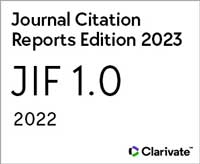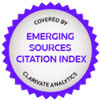North border local infrastructure financing and fiscal institutions: validating the northern border effect
Financiamiento local de infraestructura en la frontera norte e instituciones fiscales: validación del efecto frontera norte
https://doi.org/10.21670/ref.2208092
Keywords:
infrastructure financing, border effect, property tax, constitutional article 115, fiscal institutions, north border, MexicoAbstract
The objective is to acknowledge local fiscal revenue as a tool to finance infrastructure, by estimating the border effect on the collection of the property tax. A panel data set (2010-2019) of the Mexican municipalities is used to estimate different models by fixed effects. The results show that border municipalities collect $69 to $75 Mexican pesos per capita more than non-border municipalities. We argue about the use of local sources to finance infrastructure on the north border region of Mexico. In the estimation of the border effect, compared to previous studies, a broader database is used, that includes all Mexican municipalities. We conclude that institutional differences are important for explaining differences and evolution in the collection of property tax. Local sources of funding, in the face of the need for infrastructure, can be exploited if there is an adequate institutional framework.Resumen
El objetivo es reconocer el ingreso fiscal local como una alternativa de financiamiento de infraestructura, estimando el efecto frontera en la recaudación del impuesto predial. Se utiliza un panel de datos anuales (2010-2019) de los municipios mexicanos para estimar distintos modelos por efectos fijos. Los resultados muestran que los municipios fronterizos recaudan de $69 a $75 pesos per cápita más que los no fronterizos. Se argumenta sobre el uso de fuentes de financiamiento local para ampliar la infraestructura en la región frontera norte de México. En la estimación del efecto frontera, en comparación con estudios anteriores, se emplea una base de datos más amplia, que incluye todos los municipios mexicanos. Se concluye que las diferencias institucionales son importantes para explicar las diferencias y evolución en la recaudación del impuesto predial. Las fuentes de financiamiento locales, ante la necesidad de ampliar infraestructura, pueden explotarse si existe el marco institucional propicio.References
Alt, J. E. & Lowry, R. C. (1994). Divided government, fiscal institutions, and budget deficits: evidence from the states. American Political Science Review, 88(4), 811-828. https://www.jstor.org/stable/i336277 DOI: https://doi.org/10.2307/2082709
Alvarado, L. (Coord.). (2021). El impuesto predial: la oportunidad que todos dejan pasar. Ethos. https://www.ethos.org.mx/wp-content/uploads/2021/02/Predial-2021-ISBN-comprimido.pdf
Baltagi, B. H. (2001). Econometric analysis of panel data. John Wiley & Sons.
Bartle, J. R. (1995). The fiscal impact of federal and state aid to large U.S. cities: an empirical analysis of budgetary response. Public Budgeting & Finance, 15(4), 56-67. https://doi.org/10.1111/1540-5850.01053 DOI: https://doi.org/10.1111/1540-5850.01053
Bartle, J. R. (1996). The effect of intergovernmental aid on city property taxes: new results for Minnesota. Journal of Public Budgeting, Accounting & Financial Management, 8(2), 150-169. https://doi.org/10.1108/JPBAFM-08-02-1996-B001 DOI: https://doi.org/10.1108/JPBAFM-08-02-1996-B001
Bell, M. E. & Bowman, J. H. (1987). The effect of various intergovernmental aid types on local own-source revenues: the case of property taxes in Minnesota cities. Public Finance Quarterly, 15(3), 282-297. https://doi.org/10.1177%2F109114218701500303 DOI: https://doi.org/10.1177/109114218701500303
Blais, A. & Nadeau, R. (1992). The electoral budget cycle. Public Choice, 74(4), 389-403. https://www.researchgate.net/publication/316674211_The_Electoral_Budget_Cycle
Brockmeyer, A., Estefan, A., Ramírez Arras, K. & Suárez Serrato, J. C. (2021). Taxing property in developing countries: theory and evidence from Mexico (Working paper series 28627). NBER http://www.nber.org/papers/W28637 DOI: https://doi.org/10.3386/w28637
Broid Krauze, D. (2010). La evolución del predial en México: Los incentivos cruzados de la descentralización fiscal y política. Finanzas Públicas, 2(3-4), 69-192.
Buchanan, S. C. & Weber, B. A. (1982). Growth and residential property taxes: a model for estimating direct and indirect population impacts. Land Economics, 58(3), 324-337. https://www.jstor.org/stable/3145940 DOI: https://doi.org/10.2307/3145940
Cabrero Mendoza, E. (2013). Fiscal federalism in Mexico: distortions and structural traps. Urban Public Economics Review, 18, 12-36. https://www.redalyc.org/articulo.oa?id=50428804001
Canavire-Bacarreza, G. & Zúñiga Espinoza, N. G. (2015). Transferencias e impuesto predial en México. Economía UNAM, 12(35), 69-99. http://www.scielo.org.mx/scielo.php?pid=S1665-952X2015000200069&script=sci_abstract DOI: https://doi.org/10.1016/j.eunam.2015.09.004
Chávez Maza, L. A. & López Toache, V. (2019). Determinantes del recaudo del impuesto a la propiedad inmobiliaria: un enfoque estadístico para México. Revista Iberoamericana de Estudios Municipales, 10(19), 89-119. https://dx.doi.org/10.4067/S0719-17902019000100089 DOI: https://doi.org/10.4067/S0719-17902019000100089
Diario Oficial de la Federación (DOF). (2020, 3 de enero). Acuerdo por el que se da a conocer a los gobiernos de las entidades federativas la distribución y calendarización para la ministración durante el ejercicio fiscal 2020, de los recursos correspondientes a los Ramos Generales 28 Participaciones a Entidades Federativas y Municipios, y 33 Aportaciones Federales para Entidades Federativas y Municipios. https://dof.gob.mx/nota_detalle.php?codigo=5583411&fecha=03/01/2020
Erickson, C. & Eaton, D. W. (2002). Border finances: paying for environmental infrastructure. En P. Ganster (Ed.), The U.S.-Mexican border environment: economy and environment for a sustainable border region: now in 2020 (pp. 203-249, SCERP Monograph Series no. 3). San Diego State University Press.
Espinosa P., S. (2012). On bond markets development and strategic cross border infrastructure: highlights of a research agenda on regulatory harmonization (núm. 269). Repositorio Digital CIDE. http://repositorio-digital.cide.edu/handle/11651/99
Espinosa, S. & Martell, C. (2015). Building bond repayment capacity in developing countries: a study on property tax collections and debt affordability in Mexico. International Journal of Public Administration, 38(3), 227-236. https://doi.org/10.1080/01900692.2014.934841 DOI: https://doi.org/10.1080/01900692.2014.934841
Espinosa, S., Martínez, J. & Martell, C. (2018). ¿Por qué algunos municipios en México son mejores recaudadores de impuesto predial que otros? Gestión y Política Pública, 27(2), 375-395. http://www.scielo.org.mx/scielo.php?script=sci_arttext&pid=S1405-10792018000200375&lng=es&tlng=es
Espinosa, S. & Moreno, J. O. (2014). Regional development and cross-border infrastructure finance: comparing the yield-spread determinants of Mexican and U.S. sub-sovereign government bonds. The Journal of Structured Finance, 20(1), 64-75. https://doi.org/10.3905/jsf.2014.20.1.064 DOI: https://doi.org/10.3905/jsf.2014.20.1.064
Feld, L. P. & Kirchgässner, G. (2001). The political economy of direct legislation: direct democracy and local decision-making. Economic Policy, 16(33), 330-367. https://www.jstor.org/stable/1344645 DOI: https://doi.org/10.1111/1468-0327.00078
Frisvold, G. & Caswell, M. (2002). Financing bilateral water projects on the U.S.-Mexico border: past, present and future. En J. J. Batema, L. Fernandez & R. T. Carson (Eds.), Both sides of the border (The economics of non-market goods and resources, v. 2, pp. 131-159). Kluwer Academic Publishers. DOI: https://doi.org/10.1007/0-306-47961-3_8
Frisvold, G. B. & Osgood, D. E. (2011). Financing wastewater collection and treatment on the US-Mexico border. Journal of Contemporary Water Resource Education, 121(7), 40-50.
Galli, E. & Rossi, S. P: S. (2002). Political budget cycles: the case of the Western German Länder. Public Choice, 110(3-4), 283-303. https://www.jstor.org/stable/30026415 DOI: https://doi.org/10.1023/A:1013089504557
Gilbreath, J. (1992). Financing environmental and infrastructure needs on the Texas-Mexico border: will the Mexican-U.S. Integrated Border Plan help? The Journal of Environment & Development, 1(1), 151-175. https://www.jstor.org/stable/44319412 DOI: https://doi.org/10.1177/107049659200100110
Greene, W. H. (2008). Econometric analysis. Pearson.
Gurara, D., Klyuev, V., Mwase, N., Presbitero, A., Xu, X. C. & Bannister, G. (2017). Trends and challenges in infrastructure investment in low-income developing countries (WP 17/233). International Monetary Fund. https://www.imf.org/en/Publications/WP/Issues/2017/11/07/Trends-and-Challenges-in-Infrastructure-Investment-in-Low-Income-Developing-Countries-45339 DOI: https://doi.org/10.5089/9781484324837.001
Hagen, T. P. & Vabo, S. I. (2005). Political characteristics, institutional procedures and fiscal performance: Panel data analyses of Norwegian local governments, 1991-1998. European Journal of Political Research, 44(1), 43-64. https://doi.org/10.1111/j.1475-6765.2005.00218.x DOI: https://doi.org/10.1111/j.1475-6765.2005.00218.x
Henry, M. & Lambert, K. (1980). The impact of new industry on county government property tax revenue. Journal of Agricultural and Applied Economics, 12(1), 193-197. https://doi.org/10.1017/S0081305200015478 DOI: https://doi.org/10.1017/S0081305200015478
Hsiao, C. (2003). Analysis of panel data. Cambridge University Press. DOI: https://doi.org/10.1017/CBO9780511754203
Ibarra Salazar, J., González, H. & Sotres Cervantes, L. (2013). Aspectos políticos de la dependencia financiera en los municipios mexicanos. Revista Mexicana de Ciencias Políticas y Sociales, 58(217), 139-170. http://www.revistas.unam.mx/index.php/rmcpys/article/view/42181 DOI: https://doi.org/10.1016/S0185-1918(13)72278-5
Ibarra Salazar, J. & Mollick, A. V. (2006). Mexican northern border municipalities, financial dependence and institutions. The Annals of Regional Science, 40(4), 859-874. https://link.springer.com/article/10.1007/s00168-005-0036-4 DOI: https://doi.org/10.1007/s00168-005-0036-4
Ibarra Salazar, J. & Sotres Cervantes, L. (2009). Determinantes de la recaudación del impuesto predial en Tamaulipas: instituciones y zona frontera norte. Frontera Norte, 21(42), 165-192. https://doi.org/10.17428/rfn.v21i42.968
Ibarra Salazar, J. & Sotres Cervantes, L. (2013). Las instituciones fiscales como paliativo para enfrentar crisis financieras: el impuesto predial en el estado de Coahuila. En J. E. Mendoza Cota (Ed.), La crisis financiera internacional. Efectos sectoriales en México y en su frontera (pp. 315-353). El Colegio de la Frontera Norte.
Ibarra Salazar, J. & Sotres Cervantes, L. (2014). Diferencias en la recaudación del impuesto predial en la zona fronteriza: evidencia en los municipios de Chihuahua. Estudios Demográficos y Urbanos, 29(1), 53-87. https://doi.org/10.24201/edu.v29i1.1455 DOI: https://doi.org/10.24201/edu.v29i1.1455
Ibarra Salazar, J. & Sotres Cervantes, L. (2015). Property tax collection of Sonora municipalities: does border location make any difference? Journal of Borderlands Studies, 30(2), 203-225. https://doi.org/10.1080/08865655.2015.1046471 DOI: https://doi.org/10.1080/08865655.2015.1046471
Ibarra Salazar, J. & Sotres Cervantes, L. (2021). El efecto de la frontera en la recaudación del impuesto predial. Estudios Demográficos y Urbanos, 36(2), 347-401. https://doi.org/10.24201/edu.v36i2.1904 DOI: https://doi.org/10.24201/edu.v36i2.1904
Instituto Nacional de Estadística y Geografía (Inegi). (2009). Censos Económicos 2009. https://www.inegi.org.mx/programas/ce/2009/
Instituto Nacional de Estadística y Geografía (Inegi). (2010). Tabulados interactivos en Censo General de Población y Vivienda 2010. https://www.inegi.org.mx/programas/ccpv/2010/#Tabulados
Instituto Nacional de Estadística y Geografía (Inegi). (2014a). Censos Económicos 2014. https://www.inegi.org.mx/programas/ce/2014/
Instituto Nacional de Estadística y Geografía (Inegi). (2014b). Censos económicos. Sistema Automatizado de Información Censal (SAIC). www.inegi.org.mx/app/saic
Instituto Nacional de Estadística y Geografía (Inegi). (2015). Tabulados predefinidos en Encuesta Intercensal 2015. https://www.inegi.org.mx/programas/intercensal/2015/#Tabulados
Instituto Nacional de Estadística y Geografía (Inegi). (2019). Censos Económicos 2019. https://www.inegi.org.mx/programas/ce/2019/
Instituto Nacional de Estadística y Geografía (Inegi). (2020a). Banco de Información Económica (BIE). https://www.inegi.org.mx/app/indicadores/?tm=0#bodydataExplorer
Instituto Nacional de Estadística y Geografía (Inegi). (2020b). Glosario. www.inegi.org.mx/app/glosario/default.html?p=ENEU
Instituto Nacional de Estadística y Geografía (Inegi). (2020c). Censo de Población y Vivienda 2020. https://www.inegi.org.mx/programas/ccpv/2020/#Tabulados
Instituto Nacional de Estadística y Geografía (Inegi). (2020d). Estadística de finanzas públicas estatales y municipales. https://www.inegi.org.mx/sistemas/olap/proyectos/bd/continuas/finanzaspublicas/fpmun.asp?s=est&c=11289&proy=efipem_fmun
nstituto Nacional para el Federalismo y el Desarrollo Municipal (Inafed). (2021). Sistema Nacional de Información Municipal. Secretaría de Gobernación. www.snim.rami.gob.mx
Kelsey, T. W. (1993). Fiscal impacts of population growth and decline in small communities. American Journal of Agricultural Economics, 75(5), 1169-1172. https://www.jstor.org/stable/1243447 DOI: https://doi.org/10.2307/1243447
Kirchgässner, G. (2001). The effects of fiscal institutions on public finance: a survey of empirical evidence. En S. L. Winer & H. Shibata (Eds.), Political economy and public finance (pp. 145-208). International Institute of Public Finance/Edward Elgar Publishing. DOI: https://doi.org/10.2139/ssrn.292219
Mcnichol, E. C. (2017). It´s time for states to invest in infrastructure. Center on Budgetary and Policy Priorities. https://www.researchgate.net/publication/297197245_It's_Time_for_States_to_Invest_in_Infrastructure
Merrifield, J. (2000). State government expenditure determinants and tax revenue determinants revisited. Public Choice, 102(1-2), 25-50. https://www.jstor.org/stable/30026135 DOI: https://doi.org/10.1023/A:1005036918713
Nelson, M. A. (2000). Electoral cycles and the politics of state tax policy. Public Finance Review, 28(6), 540-560. https://doi.org/10.1177%2F109114210002800603 DOI: https://doi.org/10.1177/109114210002800603
Poterba, J. M. (1994). State responses to fiscal crises: the effects of budgetary institutions and politics. Journal of Political Economy, 102(4), 799-821. https://doi.org/10.1086/261955 DOI: https://doi.org/10.1086/261955
Poterba, J. M. & Von Hagen, J. (Eds.). (1999). Fiscal institutions and fiscal performance. University of Chicago Press. DOI: https://doi.org/10.7208/chicago/9780226676302.001.0001
Reed, W. R. (2006). Democrats, republicans, and taxes: evidence that political parties matter. Journal of Public Economics, 90(4-5), 725-750. https://doi.org/10.1016/j.jpubeco.2004.12.008 DOI: https://doi.org/10.1016/j.jpubeco.2004.12.008
Sánchez Almanza, A. (2000). Marginación e ingreso en los municipios de México, 1970-1990. UNAM/Miguel Ángel Porrúa.
Sankaran, H., Díaz, V. & Espinosa, S. (2013). The design and estimation of a bi-national bond to finance strategic infrastructure along the U.S.-Mexico border. The Journal of Structured Finance, 19(2), 71-88. https://doi.org/10.3905/jsf.2013.19.2.071 DOI: https://doi.org/10.3905/jsf.2013.19.2.071
Santana, S. (2000). Acciones necesarias para la implementación de la reciente reforma al artículo 115 constitucional: aspectos hacendarios. Hacienda Municipal, 72, 15-22.
Santana, S. & Sedas, C. (1999). El artículo 115 constitucional y sus reformas: comentarios a los aspectos hacendarios de la Reforma de 1999. Hacienda Municipal, 68, 21-35.
Sepúlveda, C. & Martínez-Vázquez, J. (2011). Explaining property tax collections in developing countries: the case of Latin America (International Studies Program Working Paper 11-09). Andrew Young School of Public Studies-Georgia State University. https://www.researchgate.net/publication/254391601_Explaining_Property_Tax_Collections_in_Developing_Countries_The_Case_of_Latin_America
Shadbegian, R. J. (1999). The effect of tax and expenditure limitations on the revenue structure of local government, 1962-87. National Tax Journal, 52(2), 221-237. https://doi.org/10.1086/NTJ41789391 DOI: https://doi.org/10.1086/NTJ41789391
Stein, E., Talvi, E. & Grisanti, A. (1999). Institutional arrangements and fiscal performance: the Latin American experience. En J. M. Poterba & J. Von Hagen (Eds.), Fiscal institutions and fiscal performance (pp. 103-133). Chicago University Press. DOI: https://doi.org/10.3386/w6358
Stine, W. F. (1985). Estimating the responsiveness of local revenue to intergovernmental aid. National Tax Journal, 38(2), 227-234. https://doi.org/10.1086/NTJ41792012 DOI: https://doi.org/10.1086/NTJ41792012
Stine, W. F. (1994). Is local government revenue response to federal aid symmetrical? Evidence from Pennsylvania County governments in an era of retrenchment. National Tax Journal, 47(4), 799-816. https://doi.org/10.1086/NTJ41789109 DOI: https://doi.org/10.1086/NTJ41789109
Unda Gutiérrez, M. (2018). Los límites de la recaudación predial en los municipios urbanos de México: un estudio de casos. Estudios Demográficos y Urbanos, 33(3), 601-637. https://doi.org/10.24201/edu.v33i3.1741 DOI: https://doi.org/10.24201/edu.v33i3.1741
Unda Gutiérrez, M. (2021). Una hacienda local pobre: ¿qué explica la recaudación predial en México? Estudios Demográficos y Urbanos, 36(1), 49-88. https://doi.org/10.24201/edu.v36i1.1871 DOI: https://doi.org/10.24201/edu.v36i1.1871
Unda Gutiérrez, M. & Moreno Jaimes, C. (2015). La recaudación del impuesto predial en México: un análisis de sus determinantes económicos en el periodo 1969-2010. Revista Mexicana de Ciencias Políticas y Sociales, 60(225), 45-77. http://www.revistas.unam.mx/index.php/rmcpys/article/view/51788 DOI: https://doi.org/10.1016/S0185-1918(15)30019-2
UN-Habitat. (2015). The challenge of local government financing in developing countries. United Nations Human Settlements Programme. https://unhabitat.org/the-challenge-of-local-government-financing-in-developing-countries-0
Unikel, L., Ruiz Chiapetto, C. & Garza Villarreal, G. (1976). El desarrollo urbano de México: diagnóstico e implicaciones futuras. El Colegio de México.
Von Hagen, J. (1992). Budgeting procedures and fiscal performance in the European communities (Economic Papers number 96). Commission of the European Communities. http://aei.pitt.edu/37058/1/A3038.pdf
Von Hagen, J. & Harden, I. (1995). Budget processes and commitment to fiscal discipline. European Economic Review, 39(3-4), 771-779. https://doi.org/10.1016/0014-2921(94)00084-D DOI: https://doi.org/10.1016/0014-2921(94)00084-D
Wilson, C. E. & Lee, E. (Eds.). (2013). The state of the border report: a comprehensive analysis of the U.S.-Mexico border. Wilson Center/El Colegio de la Frontera Norte/Arizona State University.
































